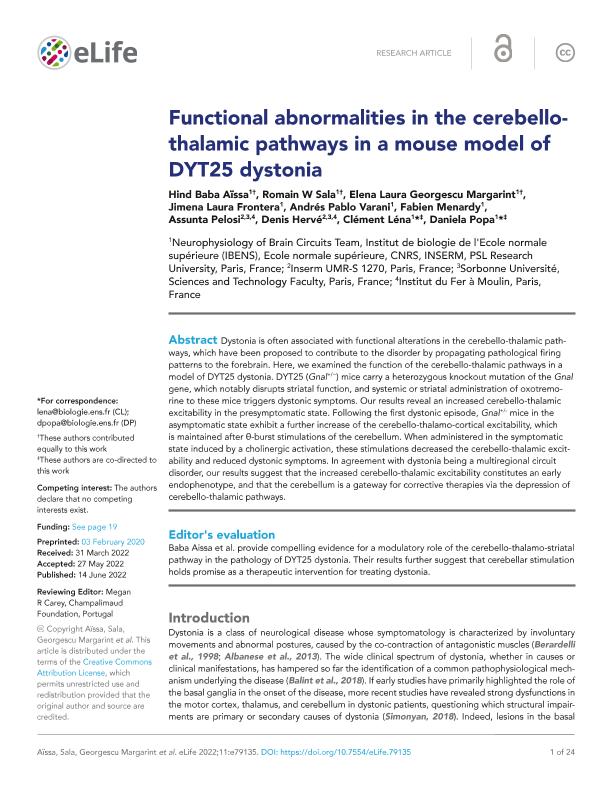Artículo
Functional abnormalities in the cerebellothalamic pathways in a mouse model of DYT25 dystonia
Aïssa, Hind Baba; Sala, Romain W.; Georgescu Margarint, Elena Laura; Frontera, Jimena Laura ; Varani, Andrés Pablo
; Varani, Andrés Pablo ; Menardy, Fabien; Pelosi, Assunta; Hervé, Denis; Léna, Clément; Popa, Daniela
; Menardy, Fabien; Pelosi, Assunta; Hervé, Denis; Léna, Clément; Popa, Daniela
 ; Varani, Andrés Pablo
; Varani, Andrés Pablo ; Menardy, Fabien; Pelosi, Assunta; Hervé, Denis; Léna, Clément; Popa, Daniela
; Menardy, Fabien; Pelosi, Assunta; Hervé, Denis; Léna, Clément; Popa, Daniela
Fecha de publicación:
06/2022
Editorial:
eLife Sciences
Revista:
eLife
ISSN:
2050-084X
Idioma:
Inglés
Tipo de recurso:
Artículo publicado
Clasificación temática:
Resumen
Dystonia is often associated with functional alterations in the cerebello-thalamic pathways, which have been proposed to contribute to the disorder by propagating pathological firing patterns to the forebrain. Here, we examined the function of the cerebello-thalamic pathways in a model of DYT25 dystonia. DYT25 (Gnal+/−) mice carry a heterozygous knockout mutation of the Gnal gene, which notably disrupts striatal function, and systemic or striatal administration of oxotremorine to these mice triggers dystonic symptoms. Our results reveal an increased cerebello-thalamic excitability in the presymptomatic state. Following the first dystonic episode, Gnal+/- mice in the asymptomatic state exhibit a further increase of the cerebello-thalamo-cortical excitability, which is maintained after θ-burst stimulations of the cerebellum. When administered in the symptomatic state induced by a cholinergic activation, these stimulations decreased the cerebello-thalamic excitability and reduced dystonic symptoms. In agreement with dystonia being a multiregional circuit disorder, our results suggest that the increased cerebello-thalamic excitability constitutes an early endophenotype, and that the cerebellum is a gateway for corrective therapies via the depression of cerebello-thalamic pathways.
Palabras clave:
GNAL
,
CEREBELLUM
,
DYSTONIA
,
ELECTROPHYSIOLOGY
,
MOTOR CORTEX
,
MOUSE
,
NEUROSCIENCE
,
THALAMUS
Archivos asociados
Licencia
Identificadores
Colecciones
Articulos(IFIBIO HOUSSAY)
Articulos de INSTITUTO DE FISIOLOGIA Y BIOFISICA BERNARDO HOUSSAY
Articulos de INSTITUTO DE FISIOLOGIA Y BIOFISICA BERNARDO HOUSSAY
Citación
Aïssa, Hind Baba; Sala, Romain W.; Georgescu Margarint, Elena Laura; Frontera, Jimena Laura; Varani, Andrés Pablo; et al.; Functional abnormalities in the cerebellothalamic pathways in a mouse model of DYT25 dystonia; eLife Sciences; eLife; 11; 6-2022; 1-24
Compartir
Altmétricas



